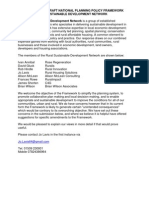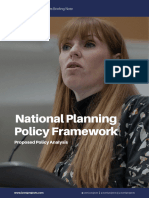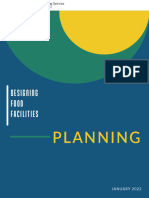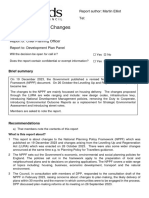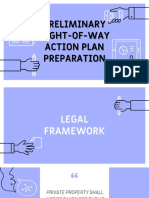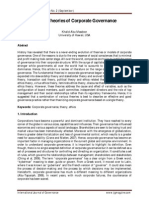Principle 2 95a
Principle 2 95a
Uploaded by
shewakenaCopyright:
Available Formats
Principle 2 95a
Principle 2 95a
Uploaded by
shewakenaOriginal Title
Copyright
Available Formats
Share this document
Did you find this document useful?
Is this content inappropriate?
Copyright:
Available Formats
Principle 2 95a
Principle 2 95a
Uploaded by
shewakenaCopyright:
Available Formats
Principle 2: Start with a clear understanding of
what your local plan must cover to address the
critical issues in your area
Guide Questions
• What are the key issues that the National Planning Policy Framework
requires your local plan to address?
• What are the difficult questions about the where and when of
development that will need to be answered?
• What is the context within which the plan is being developed, as
measured by housing supply, volume of applications and appeals, for
example?
2.1 A successful plan will make clear what development is going to be delivered
and when, where and how. The critical issues and decisions that need to be
made in relation to this will define the scope of the plan. These issues –
along with any national policy requirements that the plan must address -
should be identified and acknowledged as early as possible in the local plan
making process and must be addressed as part of its preparation.
2.2 Many soundness problems arise from a failure to properly answer the crucial
questions of when, where and how development will be delivered; National
Planning Policy Framework (NPPF), paragraphs 154, 156, 157 are relevant.
Clear answers to these questions and an unwavering focus on the critical
local issues that will shape the answers will lead to a deliverable and
worthwhile plan. A lack of focus on these matters will inevitably lead to
overly descriptive plans, generic statements and vague aspirations that could
apply anywhere –and the likelihood of your plan being found unsound.
2.3 As well as reflecting the presumption in favour of sustainable development,
the local plan must seek to meet the objectively assessed development and
infrastructure needs of the area. This can’t be emphasised strongly enough
and must be your starting point. This could include unmet needs of
neighbouring authorities, where it is reasonable to do so and consistent with
achieving sustainable development. Understanding your need comes before
looking at supply, which may be constrained by various factors. But you
must demonstrate what your objectively assessed need is, before you then
consider how you will meet it.
2.4 If you choose to define a housing target (or other area of need) at the lower
end of the range of evidence, expect the Inspector to scrutinise your
8 PAS Good Plan Making Guide
evidence closely. There are quite a few plans that have been found to be
lacking in this regard lately, and Inspectors have advised that authorities go
back and re-look at both the evidence and the conclusions on need. If you
have identified the need, but the plan isn’t meeting it, you will have to
demonstrate how the harm caused by not meeting the need is outweighed
by the harm caused by meeting it. Any restrictive policies, which may be
preventing identified need from being met, will need to be justified on the
basis of national priorities and the NPPF, such as limiting development in
National Parks and Areas of Outstanding Natural Beauty.
2.5 The critical local issues should be reflected in the objectives and strategies
to address them should be part of the plan. Delaying addressing critical
issues by the promise of preparation of later Development Plan Document
without proper justification is a dangerous approach. In addition, although
the NPPF does not preclude the production of additional Development Plan
Documents, where justified, a single plan approach is favoured (paragraph
153 of the NPPF).
2.6 Similarly, side stepping these critical issues by using Supplementary
Planning Documents (SPDs) could also result in the plan being found
unsound. An SPD cannot provide policies for development and use of land
or allocate sites or designate areas such as areas of change or conservation.
2.7 So what are these critical issues? These of course depend on your planning
area and the particular challenges faced. These are typically those matters
that lead to sharp intakes of breath when discussed with your councillors,
impassioned speeches by community leaders and are often the matters on
which community views are most polarised. Some common crunch issues -
alongside meeting housing need – are gypsy and traveller provisions, waste
plans and green belt.
2.8 Your plan must allocate land for housing: it is part of the authority’s
responsibility to do this, notwithstanding the state of the property market. If
the housing industry does not build enough homes, a lack of allocated sites
shouldn’t be one of the reasons why. A shortage of deliverable sites is
contrary to NPPF paragraph 47. Where it is not possible to identify sites for
development in the longer-term (i.e. six or more years away) broad locations
for future growth should be identified in the plan (NPPF, paragraphs 47 and
157).
2.9 Your plan must also address Gypsy and Traveller needs. The Planning
Policy for Traveller Sites, published at the same time as the NPPF, sets out
similar requirements for sites as the NPPF does for housing, with the
addition of criteria based policies for the assessment of decisions
(paragraphs 9 to 11).
2.10 The best approach is to do Gypsy and Traveller policies alongside your other
ones. Some authorities have undertaken a specific Gypsy and Traveller site
Development Plan Document at a later date following an assessment of
need. Although this may be an acceptable approach much will depend on
PAS Good Plan Making Guide 9
the urgency and level of need for sites in the area. The Examiner will seek a
commitment to address the needs of Gypsies and Travellers within an
appropriate time scale. In the absence of allocated sites, a realistic criteria
based policy will be required. If neither site allocations nor a criteria based
policy is provided you will be vulnerable on appeal.
2.11 You may also need to deal with possible changes to the Green Belt within
your area. These changes can be justified in exceptional circumstances.
These are for you to determine and justify in the light of local considerations.
Make sure there is consistency with the local plan strategy for meeting
identified requirements for sustainable development. Some authorities are
considering green belt reviews to help meet their housing need. If a review
is necessary the revised boundary should take account of the settlement
policy being followed and the need to define a permanent boundary for the
long term, beyond the plan period (NPPF paragraph 83). You will also need
to address any representations that development needs constitute
exceptional circumstances and any evidence being advanced in light of
paragraph 85 of the NPPF. You cannot and should not simply rely on the
acknowledged importance of permanent Green Belts.
2.12 Sometimes minor adjustments to remove boundary anomalies are needed in
order to maintain the integrity and logic of the Green Belt boundary. These
anomalies may, for example, have arisen because of changed patterns of
development. Whether such small-scale changes are needed is, like more
significant changes, a matter for the authority to consider. However, any
proposed changes, large or small, need to be shown in map form (preferably
inset maps) so that anyone wanting to make representations knows precisely
where the proposed boundary is located. This also applies to any proposed
boundary changes, not just to those relating to the Green Belt.
2.13 You will also need to ensure that they have adequate policies on proposals
for waste treatment, addressing: what waste management developments
and facilities are required and where, when and how they will be delivered.
Planning for waste should be treated in the same way as planning for any
other type of development.
2.14 Waste planning should both inform and in turn be informed by any relevant
municipal waste management strategy. In many instances waste planning
involves cross boundary issues, so it is important to get a co-ordinated
approach from the authorities involved. This extends to consideration of plan
impacts on those areas that will be the recipients of waste streams or
impacted by waste transfers. The need for agreement with such authorities
is vital. Failure to address this and demonstrate the duty to cooperate has
already led to an Examination on a joint waste plan being halted at the start
of an Examination hearing.
2.15 Some waste plans have failed to give sufficient geographical direction to
enable planning applications to be determined on a plan led basis.
Identification of a very extensive area does not provide adequate guidance
for subsequent site allocation Development Plan Documents, nor does it
10 PAS Good Plan Making Guide
help any private sector organisation seeking to develop a site through the
planning application route.
2.16 The issues and key questions arising from practice and examination of waste
plans are:
• Procurement and land ownership – to what extent should waste plans
take account of procurement matters and the availability of sites already
owned by the waste operators?
• Baseline information about waste streams – what waste is currently
generated by the various waste streams, how is it managed and what
factors are likely to influence the quantities and types of waste and
facilities over the plan period?
• Predicting demand and devising a strategy - uncertainties need to be
acknowledged. They can be dealt with by reasoned assumptions based
on what is known, which can then be monitored and the plan adjusted if
necessary.
2.17 The European Union Waste Framework Directive is relevant and requires
waste plans to “include a geographical map specifying the exact location of
waste disposal sites or facilities, or locational criteria which are sufficiently
precise to enable the permitting authority to determine whether or not the site
or facility falls within the management framework provided by the plan.”
Avoid producing generalised and vague waste plans. It is important to be
explicit about site allocations criteria – and justifications for sites that have
been allocated or areas of search.
2.18 The whole point of the local plan is to address the critical spatial planning
issues affecting your authority area as far as possible even when they raise
uncomfortable questions for your authority.
Further Information
Soundness Self-Assessment Checklist
PAS Duty to Cooperate – on-site support Good
Gypsy and Traveller national awareness Plan
training
Making
PAS Good Plan Making Guide 11
Frequently Asked Questions
Q: When moving to a composite local plan, what is the best way of pulling this
together in terms of presenting this for consultation and representations on
things that aren't changing? How do you present the big issues and options
for this new style plan?
A: You need to consider the language of consultation. You need to lead people
towards what you are changing. Consider how you tell the story. The NPPF does
allow for partial reviews. Where you are not proposing to change policies you need
to be satisfied you have relevant and up to date evidence underpinning them. It is
not the date per se that drives this, but whether it is still fit for purpose.
Neighbourhood plans need to be taken account of when doing the local plan, but
don't trump the need for a strategic review. The local plan does take precedence.
PINS advocates a pragmatic and sensible approach to be taken with regard to what
evidence you submit. There is no need to re-submit core strategy evidence for a
subsequent plan but it is likely to be in the document library.
Q: Should we produce an ‘Allocations and Designations Development Plan
Document’, or move to a whole local plan review. If carrying out a whole local
plan review, what is the starting point?
A: The NPPF expects that in most cases one overall local plan will be produced.
Consider the age of the Core Strategy (and any other adopted Development Plan
Documents), particularly with reference to the NPPF. Was it adopted pre-NPPF? If
so, are you satisfied that it is not in conflict with the policies in the NPPF?
The evidence base for the withdrawn core strategy can be reused where it is still up
to date as well, so it does not mean everything has to be thrown out. You can
produce separate plans but there should be good reasons why you are not
producing a single plan document.
There is a careful balance to be struck between the advantages of going through to
examination on an allocation Development Plan Document, compared with devoting
time and effort as soon as possible to an overall review of the strategy in co-
operation with neighbouring authorities, as necessary. This is especially true where
the allocations Development Plan Document is based on a core strategy that does
not meet objectively assessed needs as defined in the NPPF. This may be one
based on the Regional Strategy housing figure, and so may not fully address the
current five year supply.
Councils are advised to have very clear, well substantiated reasons why continuing
with a separate Development Plan Document is the right approach in the local
circumstances and would best contribute to the achievement of NPPF's aims. If it
were being used as a way of avoiding difficult decisions it is unlikely to be
acceptable.
12 PAS Good Plan Making Guide
Q: Can a plan be submitted that just took forward development management
policies and not site allocations, even though currently they form part of the
same draft plan?
A: The Council would be at liberty to do this but should consider if this is the best
option in terms of priorities, time, cost etc and the work that has already been done
on site allocations.
- See more at: http://www.pas.gov.uk/pm-q-a-plan-making#sthash.GSlQnqtp.dpuf
Q: For plans at different stages, timing can be an issue. Can partial reviews
be the answer to help manage this?
A: Partial reviews are possible (based only on your own plan area). However, if you
do your own review, and then a neighbouring council carries a review which later
shows you need to do more, then their more recent review may render your plan out
of date.
Q: How can you decide what to review in a plan? If there is a change in
political administration, this may lead to a desire to change certain policies.
Can these be targeted?
A: There is PINS guidance on the Planning Portal about carrying out ‘fast track'
reviews of plans
http://www.planningportal.gov.uk/uploads/pins/local_plans/discrete_policy_review_g
uidance.pdf If there is a political driver in reviewing certain aspects of the plan, then
that is clearly your starting point. However, you should also ask yourself some key
questions: How will what we change affect the rest of the plan? Will the changes
lead to a significant alteration of the overall strategy? Will we have to carry out
Sustainability Appraisal on the changes? If we are not revising the housing
requirement, can we justify this? In other words, do we know what our objectively
assessed need is? How are we using monitoring to help us understand whether
other policies require updating or revising? Do we have a 5-year land supply?
Q: When does a plan/policy become out of date? Is it the age of the
plan/policy, or is it a change in circumstances on the ground, rendering the
plan/policy out of date? What if a plan makes provision for a food store in a
town, but a food store is subsequently built on a different site within the
town? Is the allocation of the land for the food store still up to date, given the
town now has a food store?
A: The issue here is that different pieces of evidence, on which every plan is made,
will become out of date at different times. There will also be some ‘triggers' which
may make all plans potentially out of date (such as a shift in national planning
policy). So a landscape character assessment is likely to remain up to date far
longer than a strategic housing market assessment (Strategic Housing Market
Assessment). This is because the data on which the evidence relies will be updated
PAS Good Plan Making Guide 13
more regularly. A key case in point is the emergence of new Census data, and all
the household and population projections that follow on from it. Strategic Housing
Market Assessment will need to be benchmarked against updated projections, when
they come out irrespective of the date of the assessment.
The key consideration in determining whether a change in circumstance would
render a whole plan (or policy) out of date is the impact of that change on the
strategy as a whole, or the policy in particular. In the example, if the reason for the
town having an allocation for a food store is to meet some strategic policy (say,
ensuring the town retains a position in the hierarchy, and/or is made more
sustainable/competitive), then the ultimate choice of one site over another in the
town is unlikely to affect the strategy. It may well render the specific allocation
policy out of date, but even that would depend on the evidence, and whether the
town could in fact sustain more than one food store. In any event, if policies are
failing to be applied, or are rendered obsolete, the authority should pick this up in
monitoring. In every case, it is the evidence behind the policy that is crucial in
determining its continued relevance.
Q: When working on a sites and policies/allocations Development Plan
Document to deliver housing sites, is the figure adopted in Core Strategy
(from Regional Strategy) is still appropriate? Can the figure be challenged
again now?
A: The situation is changing as time moves on and the NPPF beds in. However,
you are likely to be challenged if the evidence behind the core strategy figure is now
out of date. As the hierarchy of plans has now gone, you are able to revise your
overall housing requirement in an allocations Development Plan Document.
However, you would have to understand the impact of this on the adopted core
strategy, and also ensure all evidence, particularly Sustainability Appraisal, is up to
date. Further engagement on any changes to the strategy would also have to be
undertaken.
Q: In some areas, the Regional Strategy suppressed growth to boost delivery
in the Metropolitan/growth areas. If progressing the sites and policies
Development Plan Document is considered the quickest way of getting
housing delivered, can this be supported in the light of the suppressed
Regional Strategy figure? In the short term, can we use an interim strategy
statement, retaining the Regional Strategy figure?
A: The appropriateness of an interim strategy statement is dependent on local
circumstances. It is also worth noting that the NPPF allows for a partial review of a
plan but in general favours a comprehensive local plan approach.
There is a need for cooperation across the region. Authorities in this situation also
need to address whether they have a contingency until strategic issues are
bottomed out. This could include having additional sites available to assist in
maintaining a 5-year supply.
14 PAS Good Plan Making Guide
Q: Can a local plan be prepared without development limits and allocations?
In a rural area with low delivery rates, can we use settlement development
limits and an understanding of the hierarchy of all settlements to direct
development?
A: There is a risk to the delivery of the plan if there are no allocations and there is no
work to demonstrate where there is developable and deliverable land. If there are
no suitable sites to allocate, you will need to be clear how you are delivering the
housing required. This must be identified through your work on objectively
assessed needs. Settlement boundaries and robust criteria may well be enough.
However, criteria based policies must be realistic. There may be a role for
neighbourhood plans in this scenario. The local plan would set the strategy, and
neighbourhood plans would deliver the detail in the settlements. It is important to
set out what the overall strategy is in terms of sharing out the growth around the
district (whether it be by applying a settlement hierarchy, with percentages of growth
anticipated at each, or other means). This must be fully evidenced.
Q: When should you carry out a green belt review?
A: If you are looking to review your green belt, you should attempt to consider it
within the context of its' strategic role, rather than just for your authority. That said, if
a joint review is not possible or practical, you should consider agreeing a joint
methodology, so that any alterations are being made on a consistent basis.
Q: Can you carry out a partial review if you know there is a suitable site you
could release from the green belt whilst leaving the rest unchanged?
A: In an ideal world there would be a comprehensive sub-regional review. But if the
council can build a sound story around not needing to delay, and then come back to
the strategic issue later, this may be acceptable. Different authorities seem to be
approaching it differently. There may be one single strategic site, or potential
smaller releases around settlement boundaries. Both may be appropriate
depending on the circumstances, and the evidence.
Q: Where the scale of objectively assessed needs is pointing to a green belt
review, what is the best way of progressing this? Should the council carry out
the review, seek to allocate land where required (in the green belt) and then
consult? What about the strategic nature of the green belt, where it is shared
with other authorities?
A: It would be preferable to take a comprehensive overview of the green belt when
site allocations of this magnitude may be required. And if there were implications for
the function and integrity of the green belt across a wider area, then joint working
with other planning authorities on the review is necessary. Without joint work there
is a risk of piecemeal erosion of what is actually a strategic issue. At the very least,
agreeing a common methodology for this would be beneficial (if not essential).
Linked to this is joint working on the housing need for the housing market area.
Have you worked with other authorities to seek the most sustainable way of meeting
housing needs for the housing market area? There should be really robust evidence
PAS Good Plan Making Guide 15
on reviewing the green belt. Say that the economic appraisal provides the emphasis
for investment and the need to provide perhaps larger homes than exist at present.
The Strategic Housing Market Assessment will set out existing need. Can you be
certain you can demonstrate the ‘gap' in provision, between the economic and
demographic work, that only the green belt can meet? Are you only looking to
release it to cater for larger homes? How will new developments in the green belt
link with the existing town?
Q: Can you produce an allocations Development Plan Document that does not
include gypsy and traveller sites? If the Gypsy and Traveller Accommodation
Needs Assessment is not going to be completed to the same timescale, can
you return to gypsy and traveller sites in a separate Development Plan
Document?
A: The needs of gypsies and travellers should not be treated any differently from
other housing need. Inspectors will need to be given very convincing reasons why
plans coming forward for examination do not provide for travellers' needs in
accordance with the Planning Policy for Traveller Sites (issued in March 2012). Site
allocations plans examinations have been suspended due to failure to address
travellers' needs.
Q: What is ‘strategic'? The main factor on choosing to do a single plan was
that allocations are running out and so this was a quicker way to get
allocations into a plan. This approach almost uses allocations to drive the
strategy, in so far as the public is concerned.
A: In principle doing the detail to support the strategy is the right approach. But
check that the strategy is still reasonably up to date and that the site allocations do
enough to significantly boost the housing land supply.
Q: How do you deal with safeguarded land? Can it be protected from
development?
A: The NPPF requires authorities to consider safeguarded land. It is something that
should be considered beyond the 15 years of the plan. The notion is to make any
changes to the green belt more permanent, i.e. probably two plan lifespans. The
argument that you can't protect safeguarded land is not supported.
Q: When considering how to review the green belt, it seems that focussing
solely on whether it still meets one or more of the ‘purposes' will almost
always come back with a ‘yes'. What other ways are there of assessing the
potential for release?
A: Look at similar land types. They may have different characteristics. It is an
iterative process. Start to look again at the impacts once you have made an initial
decision on potential sites. Tailor it to your specific needs. Then overlay constraint
mapping. This could take out more sites. You could also factor in built-up areas
16 PAS Good Plan Making Guide
and the potential for regeneration. Ask ‘how important is that ‘yes' when balanced
against the need for development land to provide for housing or other uses?'
Q: What about the approach to green belts in neighbourhood plans? If the
public come up with entirely different sites, will they be ignored? What are the
‘very special circumstances' that justify the release of green belt? What if a
developer doesn't want to wait for the plan and their site meets the
presumption?
A: The issue of development within the green belt is dealt with in paragraph 89 of
the NPPF. The need for development on its own is not regarded as a ‘very special
circumstance'. This will be looked at on a site by site basis. If neighbourhood plans
come up with entirely different sites, why ignore them? If they are sustainable, they
should be considered.
Q: If, as a result of an updated Strategic Housing Market Assessment, there is
an increase in the housing number, do we need to immediately start reviewing
our Core Strategy? Can we have a partial or whole review? Or is there a
threshold of increase in the housing figure that could trigger a review?
A: You will need to get on with an early review, particularly if the core strategy was
adopted prior to the NPPF. If the Strategic Housing Market Assessment shows that
your objectively assessed need is much higher than the core strategy provides for
then you stand a significant risk of losing appeals. The plan is likely to be found to
be out of date and therefore carry limited weight based on paragraphs 14 and 215 of
the NPPF.
There is also significant risk if attempting to do this as a partial review, as housing
policies are usually closely linked with the overall plan strategy. Once you start
changing the housing policies this will nearly always have consequential impacts on
other parts of the plan.
Q: It is understood that there is no longer a requirement for the chain of
conformity to be retained between the core strategy and the 'second tier'
plans. Is this correct and if so is there a maximum deviation away from the
strategic policies that the second tier plan can plan for if a need is identified?
A: Although there is no longer the need for other plans to conform to the core
strategy, something that fundamentally changes that strategy is likely to require the
strategy to be reviewed alongside allocations work. Reasons could include
significantly different levels of housing, or reviewing the green belt where a review
was not planned for.
PAS Good Plan Making Guide 17
Q: Can you replace existing core strategy policies with new ones, when
producing an allocations or other Development Plan Document?
A: It is possible to replace policies in the core strategy with policies in the allocations
document (or any other plan), provided you are clear about the fact that new policies
replace old. You also need to consult on the changes, showing the evidence behind
them. This will include updating the Sustainability Appraisal.
18 PAS Good Plan Making Guide
You might also like
- Procore Module 2 (Was & Wat)Document71 pagesProcore Module 2 (Was & Wat)Christelle Marie Aquino BeroñaNo ratings yet
- Read The EmailsDocument153 pagesRead The Emailscrainsnewyork100% (1)
- 090826103754preview - SS 546-2009Document5 pages090826103754preview - SS 546-2009atnatc0% (1)
- Philippine Housing Industry: Regulatory ReviewDocument42 pagesPhilippine Housing Industry: Regulatory ReviewAl MarzolNo ratings yet
- Law of SuccessDocument393 pagesLaw of Successalexmuchmure2158No ratings yet
- Successful Plan Makingadv 60cDocument25 pagesSuccessful Plan Makingadv 60cbabarrao768No ratings yet
- NPPF Consultation Rural Sustainable Development Network SubmissionDocument14 pagesNPPF Consultation Rural Sustainable Development Network SubmissionRob HindleNo ratings yet
- Principle 9 3abDocument3 pagesPrinciple 9 3abshewakenaNo ratings yet
- Partial Review of Subsidiary PlansDocument5 pagesPartial Review of Subsidiary Plansjessica.19.1995No ratings yet
- BDM Booklet 7Document24 pagesBDM Booklet 7ZwivhuyaNo ratings yet
- Guide To Preparing Planning ProposalsDocument24 pagesGuide To Preparing Planning ProposalsshewakenaNo ratings yet
- HEAG294 GPA4 Enabling Development and Heritage AssetsDocument28 pagesHEAG294 GPA4 Enabling Development and Heritage Assetsnahla elkassasNo ratings yet
- A Guide To Preparing Planning ProposalsDocument24 pagesA Guide To Preparing Planning ProposalsbenNo ratings yet
- M C P D: MemorandumDocument20 pagesM C P D: MemorandumPlanning DocsNo ratings yet
- Principle 1 d74Document3 pagesPrinciple 1 d74shewakenaNo ratings yet
- Local Plans FinalDocument21 pagesLocal Plans FinalManuel CassarNo ratings yet
- Current Statutory Planning Control FrameworkDocument34 pagesCurrent Statutory Planning Control Frameworkrawpaper.imageNo ratings yet
- Chap 5 Comprehensive PlaaningDocument7 pagesChap 5 Comprehensive PlaaningBryan PongaoNo ratings yet
- CD008 Circular 3.2012 - Planning Obligations and Good Neighbour Agreements (December 2012)Document21 pagesCD008 Circular 3.2012 - Planning Obligations and Good Neighbour Agreements (December 2012)Clackmannanshire CouncilNo ratings yet
- Reviewer Module 2Document9 pagesReviewer Module 2Miah EchavesNo ratings yet
- Overview of Planning and Development ProcessDocument14 pagesOverview of Planning and Development ProcessnatilaboNo ratings yet
- Operational Manual BP 4.12 - Involuntary Resettlement: Staff Connections - World Bank IntranetDocument4 pagesOperational Manual BP 4.12 - Involuntary Resettlement: Staff Connections - World Bank IntranetNitin ShitoleNo ratings yet
- Housing Project Process GuideDocument52 pagesHousing Project Process GuideNay Win MaungNo ratings yet
- 20 Feb Construction ESMP AnnexE LACPDocument6 pages20 Feb Construction ESMP AnnexE LACPAdhitya NjrengNo ratings yet
- Planning 02 Module 02 1st Sem 2023 24Document36 pagesPlanning 02 Module 02 1st Sem 2023 24Miah EchavesNo ratings yet
- Urban Studies Vol 29-5-92Document13 pagesUrban Studies Vol 29-5-92FlyANNo ratings yet
- Plan 92 MasterDocument13 pagesPlan 92 MasterVinu JohnNo ratings yet
- PROJECT CONCEPT NOTE (Letter-Format and Guidelines - Final Version (11.11.2024)Document15 pagesPROJECT CONCEPT NOTE (Letter-Format and Guidelines - Final Version (11.11.2024)salman2techNo ratings yet
- Hillside Development GuidelinesDocument24 pagesHillside Development GuidelinesJheronimus Van AkenNo ratings yet
- National Planning Policy FrameworkDocument44 pagesNational Planning Policy FrameworkrahulNo ratings yet
- Development Plan and Master PlanDocument2 pagesDevelopment Plan and Master PlanMd Shohag AliNo ratings yet
- Chapter 4 Planning SB 20 OctoberDocument28 pagesChapter 4 Planning SB 20 Octobermary.nalujjaxtraNo ratings yet
- FSR CalculationsDocument11 pagesFSR CalculationsGyanashekar K ShekarNo ratings yet
- Chapter 9Document6 pagesChapter 9Saye B.DoloNo ratings yet
- Step 7 Land Use Plan - ZBMDocument29 pagesStep 7 Land Use Plan - ZBMVlademir Geb DubouzetNo ratings yet
- Designing Food Facilities PlanningDocument19 pagesDesigning Food Facilities Planningkeneth john manayagaNo ratings yet
- CD013 Planning Advice Note 68 - Design StatementsDocument26 pagesCD013 Planning Advice Note 68 - Design StatementsClackmannanshire CouncilNo ratings yet
- ApartmentDocument15 pagesApartmentJeanne Belmonte100% (1)
- PW Comp Plan AuditDocument16 pagesPW Comp Plan Auditsavannahnow.comNo ratings yet
- Development Management GuideDocument9 pagesDevelopment Management Guideabed9631No ratings yet
- National Planning ChangesDocument7 pagesNational Planning Changesraj pawarNo ratings yet
- UNDP - Baseline and Endline Survey and Annual Progress Revies SpecsDocument13 pagesUNDP - Baseline and Endline Survey and Annual Progress Revies Specsyesuf tadesseNo ratings yet
- ROW Action PlanDocument67 pagesROW Action PlanJames Jabonero100% (1)
- Comprehensive Planning TemplateDocument21 pagesComprehensive Planning TemplateErnan BaldomeroNo ratings yet
- Neighbourhood Planning by Urban Design LondonDocument17 pagesNeighbourhood Planning by Urban Design LondonWHampsteadNo ratings yet
- Housing Planing & MangementDocument4 pagesHousing Planing & MangementarunNo ratings yet
- Issues in Mass HousingDocument5 pagesIssues in Mass HousingJardine Davies CabadduNo ratings yet
- Norms and Standards Addis Ababa Structure Plan Educational PurposeDocument39 pagesNorms and Standards Addis Ababa Structure Plan Educational PurposeItefa Anisa100% (1)
- Housing Project Process GuideDocument52 pagesHousing Project Process Guidekarri1963100% (1)
- Literature Review Local PlanDocument13 pagesLiterature Review Local PlanDm Wivinny JesonNo ratings yet
- A Steps Approach To Infrastructure Planning and Delivery: For Local Strategic Partnerships and Local AuthoritiesDocument32 pagesA Steps Approach To Infrastructure Planning and Delivery: For Local Strategic Partnerships and Local AuthoritiessokraticNo ratings yet
- CDP+ Course 2Document47 pagesCDP+ Course 2Keith Clarence BunaganNo ratings yet
- 16 BP 4.12 Involuntary Resettlement - InggrisDocument5 pages16 BP 4.12 Involuntary Resettlement - InggrisfachrynaNo ratings yet
- Land Used Planning Presentation1Document31 pagesLand Used Planning Presentation1Habtamu YalewNo ratings yet
- Resilient Urban Design and Development GuidelinesDocument44 pagesResilient Urban Design and Development GuidelinesKarl Vincent SantosNo ratings yet
- CABE Space - A Guide To Producing Park and Green Space Management PlansDocument48 pagesCABE Space - A Guide To Producing Park and Green Space Management PlansbenconnolleyNo ratings yet
- Importante Anexo 2Document9 pagesImportante Anexo 2MARCOFSPNo ratings yet
- Instituting Space - Draft 18.04.21 Final Final Proofed AJDocument43 pagesInstituting Space - Draft 18.04.21 Final Final Proofed AJThomas FischerNo ratings yet
- NWMCOG - Master Plans Fact SheetDocument2 pagesNWMCOG - Master Plans Fact SheetGary HoweNo ratings yet
- Report-Layout Housing-Industry 050819ADocument6 pagesReport-Layout Housing-Industry 050819Adocwit10No ratings yet
- Country Knowledge Plan Process Manual: Developing a Dynamic Country Knowledge Plan for ADB Developing Member CountriesFrom EverandCountry Knowledge Plan Process Manual: Developing a Dynamic Country Knowledge Plan for ADB Developing Member CountriesNo ratings yet
- Reaching the Sustainable Development Goals Through Better Local-Level Data: A Case Study on Lumajang and Pacitan Districts in IndonesiaFrom EverandReaching the Sustainable Development Goals Through Better Local-Level Data: A Case Study on Lumajang and Pacitan Districts in IndonesiaNo ratings yet
- Numerical Solution of Ordinary Differential EquationsDocument10 pagesNumerical Solution of Ordinary Differential Equationsjymuzo7793No ratings yet
- IRD306 User Manual v4 Aug14Document31 pagesIRD306 User Manual v4 Aug14ManicharanNo ratings yet
- Issue Tracking TemplateDocument4 pagesIssue Tracking Templatesptn5hxkx5No ratings yet
- Grad School SeminarDocument32 pagesGrad School SeminarchemistryWITNo ratings yet
- A Tutorial For Electronic Circuit ...Document5 pagesA Tutorial For Electronic Circuit ...Chito June TumolvaNo ratings yet
- Find Your Ring Size: Printing InstructionsDocument1 pageFind Your Ring Size: Printing Instructionsdebra langstonNo ratings yet
- ASME B16: Standardization of Valves, Flanges, Fittings, and Gaskets # Standard DesignationDocument6 pagesASME B16: Standardization of Valves, Flanges, Fittings, and Gaskets # Standard DesignationNicolás MerinoNo ratings yet
- Data Flow DiagramDocument2 pagesData Flow DiagramSreedivya KsNo ratings yet
- Susumu TakenagaDocument7 pagesSusumu TakenagaFelipe Batista De SouzaNo ratings yet
- Actual Question Paper & Answer Key For MdesDocument33 pagesActual Question Paper & Answer Key For Mdesabhijna anilNo ratings yet
- Chapter 06Document28 pagesChapter 06bchang412No ratings yet
- Kestrel Heat Index Reference Guide Celsius: !! WARNING!!Document2 pagesKestrel Heat Index Reference Guide Celsius: !! WARNING!!joker batmanNo ratings yet
- Resume AimanDocument4 pagesResume Aimannuaim kadirNo ratings yet
- Logical Reasoning Mock Test - 29Document13 pagesLogical Reasoning Mock Test - 29Bharath BharuNo ratings yet
- Preparation of Papers in Modified IEEE Style: 1.5-Spaced, One ColumnDocument6 pagesPreparation of Papers in Modified IEEE Style: 1.5-Spaced, One ColumnhavejsnjNo ratings yet
- Einstein Relations: Prof - Siva PrasadDocument11 pagesEinstein Relations: Prof - Siva PrasadRenuNo ratings yet
- GBE Assignment Marking SchemeDocument1 pageGBE Assignment Marking SchemeRamendran NairNo ratings yet
- WEG India Staff Contact Numbers PDFDocument10 pagesWEG India Staff Contact Numbers PDFM.DINESH KUMARNo ratings yet
- Auxiliary Programs - EnergyPlus DocumentationDocument144 pagesAuxiliary Programs - EnergyPlus DocumentationAditi SharmaNo ratings yet
- Magazine For Civil Engineering StudentsDocument15 pagesMagazine For Civil Engineering StudentsPao LeañoNo ratings yet
- CalicDocument4 pagesCalicgunjan2006No ratings yet
- Círculo: Relevance Versus Connection: Discourse and Text As Units of AnalysisDocument10 pagesCírculo: Relevance Versus Connection: Discourse and Text As Units of AnalysisLealyn MaquinianoNo ratings yet
- 3 - Content - Introduction To Java, JVM, JDK PDFDocument8 pages3 - Content - Introduction To Java, JVM, JDK PDFAnonymous zdY202lgZYNo ratings yet
- EMT Crash Course With Online Practice Test 2nd Edition All Chapter Instant DownloadDocument34 pagesEMT Crash Course With Online Practice Test 2nd Edition All Chapter Instant Downloadjalihareka91100% (1)
- PSDCDocument124 pagesPSDCanushreesanikop100% (3)
- Theories of CGDocument9 pagesTheories of CGmariamelatiNo ratings yet
- Fine Tuning Process DarshanDocument3 pagesFine Tuning Process Darshansharathdinesh23No ratings yet






